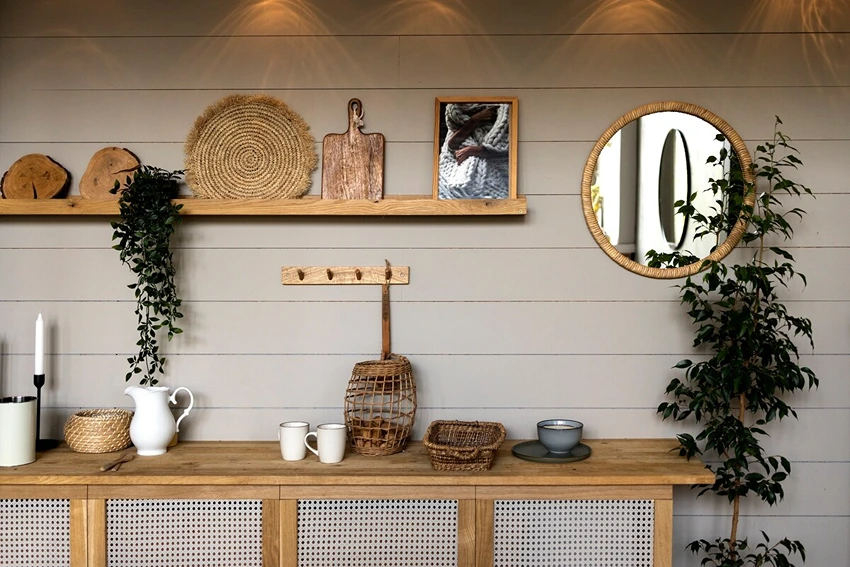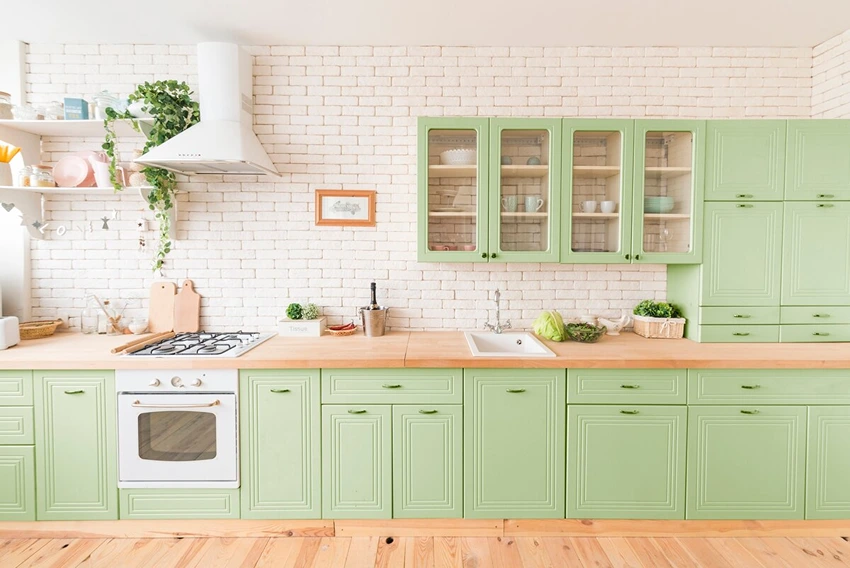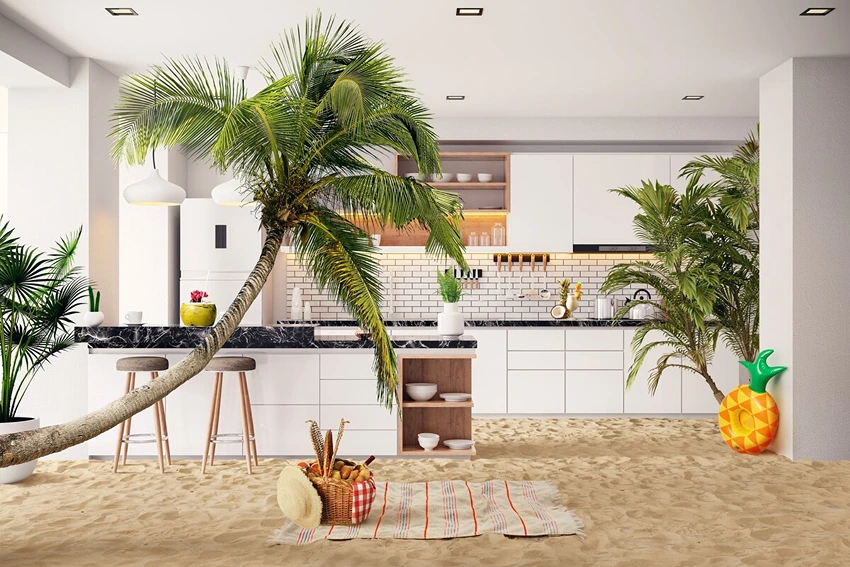Eco-friendly kitchen design is not just a trend; it’s a commitment to a sustainable lifestyle. By integrating principles of sustainability, energy efficiency, and waste reduction, we can create kitchen spaces that are not only beautiful but also kind to our planet.
Key Takeaways:
- Sustainable Materials: Opt for cabinetry, countertops, and flooring made from recycled or renewable resources.
- Energy Efficiency: Choose energy-saving appliances and LED lighting to reduce power consumption.
- Water Conservation: Install efficient faucets and adopt practices to minimize water usage.
Key Principles of Eco-Friendly Kitchen Design
Eco-friendly kitchen design revolves around three core principles: sustainability, energy efficiency, and waste reduction. Each element, from the materials used to the appliances installed, plays a crucial role in creating an environmentally friendly kitchen.

Choosing Sustainable Materials
When selecting materials for your kitchen, consider their environmental impact. Opt for cabinetry, countertops, and flooring made from sustainable resources. These materials not only reduce the carbon footprint but also add a natural aesthetic to your kitchen.
Cabinetry:
- Recycled Wood: Cabinets made from recycled wood reduce deforestation.
- Bamboo: A fast-growing, renewable resource that offers durability.
Countertops:
- Recycled Glass: A stylish and sustainable option.
- Composite Materials: Made from recycled paper or agricultural fibers.
Flooring:
- Cork: A renewable material that provides natural insulation.
- Linoleum: Made from natural materials like linseed oil and wood flour.
Energy-Efficient Appliances and Lighting
Energy efficiency is a cornerstone of eco-friendly kitchen design. Choosing the right appliances and lighting can significantly reduce your kitchen’s energy consumption.
Appliances:
- Energy Star Certified: Look for appliances with the Energy Star label for maximum efficiency.
- Smart Appliances: These can be programmed to operate at off-peak hours, saving energy.
Lighting:
- LED Lighting: LED bulbs are more energy-efficient and have a longer lifespan than traditional bulbs.
- Natural Light: Maximize natural light to reduce the need for artificial lighting.

Water Conservation Strategies
Water conservation is vital in eco-friendly kitchen design. Efficient faucets and mindful water usage can make a significant difference.
Efficient Faucets:
- Low-Flow Faucets: These reduce water flow without compromising performance.
- Sensor Taps: Automatically turn off to prevent water wastage.
Water Usage Tips:
- Full Dishwasher Loads: Run the dishwasher only when it’s full to save water.
- Fix Leaks: Repairing drips can save gallons of water over time.
Table: Water Conservation Statistics
| Strategy | Water Savings |
| Low-Flow Faucets | Up to 30% reduction in water usage |
| Repairing Leaks | Can save 9,400 gallons annually |
| Full Dishwasher Loads | Saves nearly 320 gallons annually |
| Sensor Taps | Reduces water wastage significantly |
Innovative Eco-Friendly Kitchen Technologies
Embracing new technologies can enhance the eco-friendliness of your kitchen. From smart appliances to energy-efficient systems, these innovations are paving the way for a greener future.

Smart Kitchen Appliances:
- Smart Refrigerators: Can adjust cooling based on usage patterns.
- Energy Monitoring Systems: Track and optimize energy usage.
Sustainable Kitchen Gadgets:
- Compost Bins: Turn kitchen waste into garden compost.
- Eco-Friendly Cookware: Non-toxic and energy-efficient cooking options.
For more ideas on how to make your kitchen greener, check out these eco-friendly kitchen accessories. From reusable storage bags to bamboo utensils, these accessories not only reduce waste but also add a touch of sustainability to your daily cooking routine.
Designing for Longevity and Timelessness
An eco-friendly kitchen should be designed to stand the test of time, both in style and functionality. Durable materials and timeless designs ensure that your kitchen remains relevant and functional for years to come.
Durable Materials:
- Quartz Countertops: Resistant to scratches and stains.
- Hardwood Cabinets: Long-lasting and can be refinished.
Timeless Design Elements:
- Neutral Colors: Classic and versatile.
- Simple Lines: Clean and enduring designs.
Incorporating Nature and Biophilic Design
Biophilic design connects the indoors with the natural world, creating a harmonious and calming kitchen environment. For those interested in exploring this further, biophilic design kitchens offer a wealth of inspiration. By incorporating elements such as indoor plants, natural light, and materials inspired by nature, you can create a kitchen space that not only looks beautiful but also promotes well-being and a deeper connection to the natural world. Incorporating elements of nature into your kitchen design can have numerous benefits.

Natural Elements:
- Indoor Plants: Improve air quality and add a touch of greenery.
- Natural Light: Large windows or skylights to bring in sunlight.
Materials Inspired by Nature:
- Stone Backsplashes: A natural and elegant touch.
- Wooden Accents: Bring warmth and texture.
Innovative Eco-Friendly Kitchen Technologies
Embracing technology is key to enhancing the eco-friendliness of your kitchen. From energy-efficient appliances to smart systems, these innovations offer both functionality and sustainability.

Energy-Efficient Appliances:
Modern appliances are designed to be more energy-efficient, reducing both your carbon footprint and utility bills.
Energy Star Certified Appliances:
- Refrigerators: Consume less energy compared to older models.
- Dishwashers: Use less water and energy, saving resources.
Smart Kitchen Systems:
- Smart Thermostats: Regulate kitchen temperature efficiently.
- Energy Monitoring: Track and manage energy usage in real-time.
Table: Energy Efficiency of Appliances
| Appliance Type | Energy Savings |
| Refrigerators | Up to 20% more efficient than standard models |
| Dishwashers | Save more than 5,000 gallons of water over their lifetime |
| Smart Thermostats | Reduce heating and cooling energy use by 8-15% |
Source: Energy Star
Designing for Longevity and Timelessness
Creating a kitchen that withstands the test of time in both style and functionality is essential for sustainability. Durable materials and classic designs ensure longevity and reduce the need for frequent renovations.

Durable and Timeless Materials:
- Quartz and Granite Countertops: Resistant to wear and tear.
- Solid Wood Cabinets: Can be refinished and updated.
Timeless Design Elements:
- Neutral Color Palettes: Always in style and easy to update.
- Classic Layouts: Functional and enduring kitchen designs.
Incorporating Nature and Biophilic Design
Biophilic design brings the outdoors inside, creating a kitchen space that is both aesthetically pleasing and beneficial for well-being.
Natural Elements:
- Indoor Plants: Improve air quality and add natural beauty.
- Natural Materials: Use of stone, wood, and natural fibers.
Maximizing Natural Light:
- Skylights and Large Windows: Reduce the need for artificial lighting.
- Reflective Surfaces: Enhance natural light distribution.
Frequently Asked Questions
Addressing common queries about eco-friendly kitchen design:
- Sustainable Wood: Bamboo, reclaimed wood.
- Recycled Materials: Glass countertops, recycled metal hardware.
- Upgrade to Energy Star Appliances: Refrigerators, dishwashers, ovens.
- Use LED Lighting: Replace old bulbs with energy-efficient LEDs.
- Install Low-Flow Faucets: Reduce water usage without sacrificing performance.
- Fix Leaks Promptly: Even small drips can waste significant amounts of water.
Related Posts
Future Kitchen Technologies: Revolutionizing Home Cooking and Design
The kitchen, often considered the heart…
Tech-Advanced Kitchen Design: The Future of Culinary Spaces
The kitchen, traditionally the heart of…




